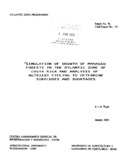| dc.contributor.author | Poels, R.L.H. | |
| dc.date.accessioned | 2014-10-18T03:18:47Z | |
| dc.date.available | 2014-10-18T03:18:47Z | |
| dc.date.issued | 1995 | es_ES |
| dc.identifier | 305965 | es_ES |
| dc.identifier.uri | https://repositorio.catie.ac.cr/handle/11554/3978 | |
| dc.description | 68 pág, 24 ilus, 9 tab, 37 ref. También como Report no. 96 | es_ES |
| dc.description.abstract | Growth of a managed natural forest and a forest plantation in the Atlantic Zone of Costa Rica were simulated with the TROPFOR programme and the resulting organic matter flows combined with concentrations of plant components to calculate nutrient flows. Goal of the investigations was to determine the capacities of three soil types to produce timber in managed natural forests and in plantations and to determine the sustainability of these land uses form a nutrient point of view. A climate file was constructed with 5 years of actual daily weather data: rainfall, short wave radiation, maximum and minimum temperature, vapour pressure and wind speed. Missing values of short wave radiation were calculated with the Angstrom equation, that was adjusted for the Atlantic Zone conditions. A soil file was made with hydrological characteristics for 3 representative soil types occurring in the Atlantic Zone: a well drained young soil (fertile), a poorly drained soil and a well drained old soil of low fertility. A vegetation input file was made with growth characteristics for natural forest and for a teak plantation. The climate, soil and vegetation files were used as input in the TROPFOR programme, that calculated for each day during 20 years the development of both vegetations: assimilation, maintenance respirations, formation of plant components and litter production and the influence of silvicultural activities on these processes. Simulated productions are the maximum productions that can be expected under current climatic and soil conditions when nutrient supply is not limiting. Amounts of N, P, K, Ca and Mg needded for the simulated production per year and the amounts of the same elements that are liberated by litter decomposition per year were compared in nutrient balances. Also the inputs by the atmosphere and by weathering were included in these balances, especially to compare these inputs with the exports of nutrients with harvested stemwood. It was found that the land utilization type (LUT) Managed Natural Forests with light harvests every 20 year can be sustainable on all three soil types from a nutrient point of view, both in the short and in the long run. The LUT Forest Plantation is not sustainable without input of nutrients, Large nutrient deficiencies develop during the first cycle caused by phytomass build-up. High nutrient buffering capacities are needed to take up surpluses and to supply shortages of nutrients caused by the phytomass fluctuations that are much larger in the plantation than in managed natural forest. Even on soils with extremely high nutrient buffering capacities probleMON will occur in the long run by the export of nutrients with stemwood. | es_ES |
| dc.language.iso | en | es_ES |
| dc.publisher | CATIE, Turrialba (Costa Rica) Ministerio de Agricultura y Ganadería, San José (Costa Rica) Agricultural University Wageningen, Wageningen (Países Bajos) | es_ES |
| dc.relation.ispartof | Field Report - Atlantic Zone Programme / CATIE-AUW-MAG ; número 142 | |
| dc.subject | CARACTERISTICAS DEL SITIO | es_ES |
| dc.subject | SIMULACION | es_ES |
| dc.subject | CRECIMIENTO | es_ES |
| dc.subject | FACTORES EDAFICOS | es_ES |
| dc.subject | NUTRIENTES | es_ES |
| dc.subject | ORDENACION FORESTAL | es_ES |
| dc.subject | BOSQUE TROPICAL HUMEDO | es_ES |
| dc.subject | COSTA RICA | es_ES |
| dc.title | Simulation of growth of managed forests in the Atlantic Zone of Costa Rica and analysis of nutrient cicling to determine surpluses and shortages | es_ES |
| dc.type | MON | es_ES |


